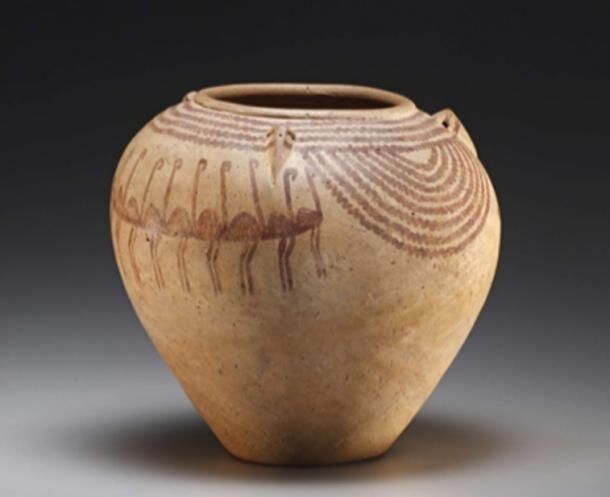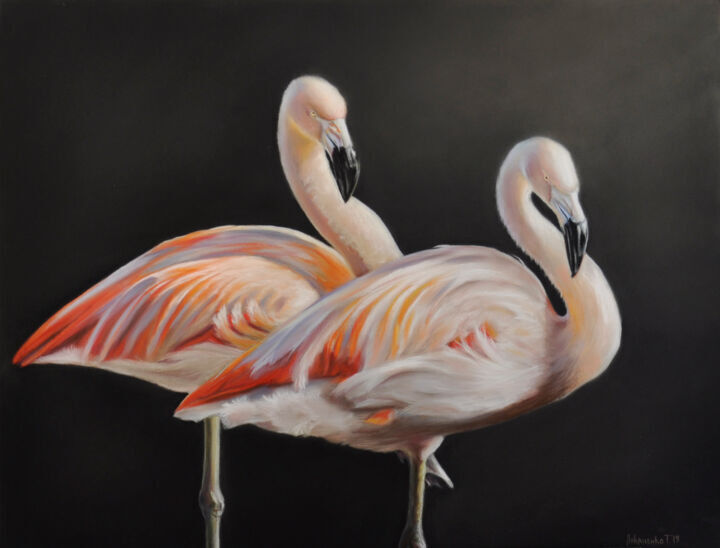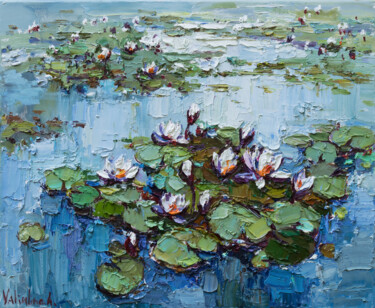 Anna Chekushkina, Flamingo, 2020. Acrylic/oil on canvas, 100 x 110 cm.
Anna Chekushkina, Flamingo, 2020. Acrylic/oil on canvas, 100 x 110 cm.
The flamingo: some curiosities
The flamingo is an aquatic bird whose most obvious peculiarity is the pink color, sometimes reddish, of its plumage. These animals, distributed almost all over the world, are found mainly in the Caribbean Sea, Africa, the Mediterranean basin, the Persian Gulf and India, occupying mainly salty and alkaline lakes, lagoons and delta of rivers. The flamingos live in numerous colonies and are very long-lived, in fact, they arrive on average up to the age of 25 years. These birds are also characterized by a great romanticism, since, generally monogamous, they make a fixed couple for many years. The choice of the partner happens after a specific courtship ritual: a sort of dance in the water. This event will give birth to a single new born, since the female of the species is able to lay only one egg per year, which will be incubated by the parents for about 28-32 days. The chick will initially be grey, because its plumage will turn pink with time, thanks to the carotene contained in the algae and shrimps these animals eat. Finally, a last curiosity about flamingos concerns their way of sleeping: they rest on their feet, on one leg only, probably to disperse less body heat.
 Egyptian vase decorated with Nilotic scenes, ca. 3700-3300 BC.
Egyptian vase decorated with Nilotic scenes, ca. 3700-3300 BC.
 Flamingo, 6th century. Detail of the atrium mosaic of a palace complex outside the city walls of Byzantine Caesarea, Caesarea Maritima, Israel.
Flamingo, 6th century. Detail of the atrium mosaic of a palace complex outside the city walls of Byzantine Caesarea, Caesarea Maritima, Israel.
Ancient art: the popularity of the flamingo
The silhouette of the flamingo appears immortalized, perhaps for the first time, within the precious hieroglyphics of ancient predynastic Egypt, where, through the symbol of this animal, they wanted to allude to the color red. In addition, attributable to the same period are also some vases, which were decorated with the image of this elegant and refined bird. In Roman times, besides being appreciated as a gastronomic delicacy, flamingos were precious gifts for lovers and popular decorative elements in mosaic art. In fact, many mosaic ornaments from the southern Mediterranean area, executed between the 1st and 7th centuries, show the great popularity of this bird in the collective imagination. Within this context, the mosaic decorations executed within many early Christian buildings stand out, where, on some occasions, the flamingo was immortalized within scenarios rich in lush vegetation, intended to allude to the preciousness of paradise. Finally, examples of early Christian art that depicted flamingos can be found: in the basilica of Sabratha (Libya), in the synagogue of Gaza Maiumas (Israel), in the funerary chapel of Polieyctos in Constantinople and in the basilica of Qasr Elbia (Libya).
 Arnaud Feuga, Réveil de flamands roses 1, 2016. Oil on canvas, 50 x 73 cm.
Arnaud Feuga, Réveil de flamands roses 1, 2016. Oil on canvas, 50 x 73 cm.
 Tatyana Lukanenko, Flamingo, 2019. Pastel on cardboard, 59 x 74 cm.
Tatyana Lukanenko, Flamingo, 2019. Pastel on cardboard, 59 x 74 cm.
Contemporary art: the "revival" of the flamingo
Within modern Western culture, the flamingo began to be widely popular during the 1950s, when, in the field of design, Don Featherstone, an employee of the U.S. company Union Products, came up with the iconic plastic lawn ornaments in the shape of the aforementioned bird. Despite the great success of this invention, it recorded a sudden and strong crisis during the following decade, caused by the aversion of the Hippie culture towards the plastic industry. Later, the iconography of the pink flamingo came back in vogue during the sixties, but became a symbol of rebellion, outrage and bad taste. Only in the eighties it became an acclaimed artistic subject, indelibly linked to Pop culture. In more recent times we have witnessed a "revival" of this animal, which has spread like wildfire in the fashion and design industry, but also within the art world. This is because it has finally been highlighted all the joy and positivity emanating from this graceful bird, which has become a symbol of universal love. In fact, it is believed that the flamingo, directly connected to the energy of the heart chakra, is able to foster interpersonal relationships in respect and care for others. What's more, the flamingo is a symbol of balance, sensitivity, rebirth, altruism, charm and elegance, associated with the four elements: water, air, fire and earth. Water, in which it is immersed to feed itself, represents the psyche, the human soul and purification. Air is the symbol of the invisible, of the "flight" within our spirituality. The earth is linked to the cyclical nature of events, balance and aspects related to materiality, which, if exasperated, produces vanity and ostentation. Finally, fire is an element of purification and regeneration, associated with solar energy that allows us to be reborn.
Contemporary Interpretations
 Dominic Virtosu, Social distancing, 2021. Oil on canvas, 205 x 275 cm.
Dominic Virtosu, Social distancing, 2021. Oil on canvas, 205 x 275 cm.
Dominic Virtosu: Social distancing
The artists of Artmajeur have extensively investigated and experimented with the iconography of the flamingo, depicting it in a variety of contexts and situations, accompanying it with its peers and sometimes with humans or other animals. In addition, the flamingo has also been depicted in the form of objects, as exemplified by the friendly and popular inflatables that crowd the sea in Dominic Virtosu's painting Social distancing. In this 2020 oil painting, the flamingo takes on a new, innovative and highly original meaning, as it is used to refer to the social distance imposed during the second wave of Covid-19. In fact, the women with their faces concealed, ignoring the danger of the open sea, are intent on sunbathing on top of their inflatables, standing at a strategic distance from each other, allowing the most total indifference to the existence of others. Finally, this work, surreal and highly charged with meaning, also represents a snapshot of the consumer world, where products that homologate the masses are widespread and where the cult of individualism triumphs.
 Natalia Rezanova, Birds of the morning dawn, 2015. Acrylic on canvas, 90 x 70 cm.
Natalia Rezanova, Birds of the morning dawn, 2015. Acrylic on canvas, 90 x 70 cm.
Natalia Rezanova: Birds of the morning dawn
The personal "realism" of the acrylic by the artist of Artmajeur, Natalia Rezanova, represents, in its precision, finesse and fidelity of execution, a clear celebration of the beauty of the flamingo which, immortalized in its natural environment, in a multitude of colored specimens, strongly expresses the positivity of which today it has become a symbol. Moreover, the work presents a decisive perspective cut, photographic and instantaneous, almost as if the artist had painted "en plein air", finding herself observing directly the delicacy and the royalty of this bird with its almost unreal colors and features. Finally, Natalia Rezanova's own words perfectly sum up the subject depicted: the flamingo truly has something fabulous and magical about it, that synthes the hues of dawn, the color of a new rebirth and renewal.
 Nikolina Petolas, Mindfulness for beginners, 2017. Photomontage on paper, 45 x 65 cm.
Nikolina Petolas, Mindfulness for beginners, 2017. Photomontage on paper, 45 x 65 cm.
Nikolina Petolas: Mindfulness for beginners
The photomontage of Artmajeur's artist Nikolina Petolas allows us to dream, that is, to give life to images, which are able to connect to parallel realities until now only imagined, where the beauty of animals blends with the luxury of an elegant and well-furnished home. Probably, in this work the flamingo has been depicted to best express the characteristics of the elements of water and earth to which it is linked. In fact, like water, which represents the human psyche, the photomontage allows us to explore the inner world of the artist and, in affinity with the earth, we come into contact with the vanity and ostentation of the rich environment depicted. In line with what has been said, the title of the work, Mindfulness for beginners, summarizes the intent of Nikolina Petolas: to create a photomontage that represents an initiatory journey to discover a surreal world.


 Olimpia Gaia Martinelli
Olimpia Gaia Martinelli























